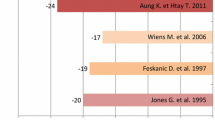Abstract
Several clinical trials indicate a dramatic loss of bone mineral density culminating in osteoporosis during long–term therapy with valproate (VPA). There is no agreement on the underlying mechanism, since VPA caused different effects on blood markers of calcium and bone metabolism in several trials. Possible mechanisms are renal tubular dysfunction, interference of electric coupling between osteoblasts, a decrease of IGF–1 production and an imbalance between activation of osteoblasts and osteoclasts. Different recommendations on treatment of VPA–induced osteopenia are summarized. In conclusion, measurement of bone mineral density at regular intervals as well as individual therapy in collaboration with a specialist for bone metabolism is advisable.
Zusammenfassung
Mehrere Studien zeigen unter Langzeittherapie mit Valproat (VPA) eine dramatische Abnahme der Knochendichte bis hin zur Osteoporose. Über den zugrundeliegenden Mechanismus besteht Uneinigkeit, da sich die Auswirkungen von VPA auf biochemische Marker des Kalzium– und Knochenstoffwechsels in den durchgeführten Untersuchungen unterschiedlich darstellten. Diskutiert werden eine renal–tubuläre Dysfunktion, Beeinflussung der elektrischen Kopplung von Osteoblasten, Abnahme der IGF–1–Produktion und eine Erhöhung des Knochenumbaus mit Verschiebung des Aktivierungsgleichgewichts zwischen Osteoblasten und Osteoklasten zugunsten letzterer. Auch für die Therapie der VPA–induzierten Osteopenie gibt es unterschiedliche Empfehlungen. Regelmäßige Knochendichtemessungen und eine individuell abgestimmte Therapie in Zusammenarbeit mit einem Knochenspezialisten ist ratsam.
Similar content being viewed by others
References
Akin R, Okutan V, Sarici U, Altunbas A, Gokcay E (1998) Evaluation of bone mineral density in children receiving antiepileptic drugs. Pediatric Neurology 19:129–131
Boluk A, Guzelipek M, Savli H, Temel I, Ozisik HI, Kaygusuz A (2004) The effect of valproate on bone mineral density in adult epileptic patients. Pharmacological Research 50:93–97
Caksen H, Dulger H, Cesur Y, Odabas D, Tuncer O, Atas B (2002) No effect of long–term valproate therapy on thyroid and parathyroid functions in children. The International Journal of Neuroscience 112:1371–1374
Christenson RH (1997) Biochemical markers of bone metabolism: an overview. Clinical biochemistry 30:573– 593
Drezner MK (2004) Treatment of anticonvulsant drug–induced bone disease. Epilepsy & Behavior 5(Suppl 2):S41–47
Ecevit C, Aydogan A, Kavakli T, Altinoz S (2004) Effect of carbamazepine and valproate on bone mineral density. Pediatric Neurology 31:279–282
Federico G, Baroncelli GI, Vanacore T, Fiore L, Saggese G (2003) Pubertal changes in biochemical markers of growth. Hormone research 60(Suppl 1):46–51
Guo CY, Ronen GM, Atkinson SA (2001) Long–term valproate and lamotrigine treatment may be a marker for reduced growth and bone mass in children with epilepsy. Epilepsia 42:1141–1147
Kafali G, Erselcan T, Tanzer F (1999) Effect of antiepileptic drugs on bone mineral density in children between ages 6 and 12 years. Clinical pediatrics 38:93–98
Kruse R (1968) Osteopathien bei antiepileptischer Langzeittherapie. Monatsschrift für Kinderheilkunde 116:378–381
Öner N, Kaya M, Karasalihoglu S, Karaca H, Celtik C, Tutunculer F (2004) Bone mineral metabolism changes in epileptic children receiving valproic acid. Journal of Paediatrics and Child Health 40:470–473
Pack AM, Morrell MJ, Flynn KL, Done S (2001) Possible mechanisms of bone disease in women receiving antiepileptic drug (AED) monotherapy. Abstract. Epilepsia 42(Suppl 7):292
Pack AM, Morrell MJ, Marcus R, Holloway L, Flaster E, Done S, Randall A, Seale C, Shane E (2005) Bone mass and turnover in women with epilepsy on antiepileptic drug monotherapy. Ann Neurol 57:252–257
Pedrera JD, Canal ML, Carvajal J, Postigo S, Villa LF, Hernandez ER, Rico H (2000) Influence of vitamin D administration on bone ultrasound measurements in patients on anticonvulsant therapy. European Journal of Clinical Investigation 30:895–899
Rieger–Wettengl G, Tutlewski B, Stabrey A, Rauch F, Herkenrath P, Schauseil– Zipf U, Schoenau E (2001) Analysis of the musculoskeletal system in children and adolescents receiving anticonvulsant monotherapy with valproic acid or carbamazepine. Pediatrics 108:E107
Robinson PB, Harris M, Harvey W, Papadogeorgakis N (1982) Reduced bone growth in rats treated with anticonvulsant drugs: a type II pseudohypoparathyroidism? Metabolic bone disease & related research 4:269–275
Sato Y, Kondo I, Ishida S, Motooka H, Takayama K, Tomita Y, Maeda H, Satoh K (2001) Decreased bone mass and increased bone turnover with valproate therapy in adults with epilepsy. Neurology 57:445–449
Schirrmacher K, Brummer F, Dusing R, Bingmann D (1993) Dye and electric coupling between osteoblast–like cells in culture. Calcified tissue international 53:53–60
Sheth RD, Wesolowski CA, Jacob JC, Penney S, Hobbs GR, Riggs JE, Bodensteiner JB (1995) Effect of carbamazepine and valproate on bone mineral density. The Journal of Pediatrics 127:256–262
Tillmann F, Kruppa E, Grun R, Blaschke S, Delling G (1999) Erhöhte Frakturneigung bei einer 67–jährigen Patientin mit Hypokalzämie unklarer Ätiologie. Der Internist 40:1093–1096
Vestergaard P, Rejnmark L, Mosekilde L (2004) Fracture risk associated with use of antiepileptic drugs. Epilepsia 45:1330–1337
Wu S, Legido A, De Luca F (2004) Effects of valproic acid on longitudinal bone growth. Journal of Child Neurology 19:26–30
Zofkova I (2003) Pathopysiological and clinical importance of insulinlike growth factor–1 with respect to bone metabolism. Physiological Research 52:657–679
Author information
Authors and Affiliations
Corresponding author
Rights and permissions
About this article
Cite this article
Rosenow, F., Hamer, H. & Bauer, S. Valproat und Knochenstoffwechsel. Z. Epileptol. 18, 170–173 (2005). https://doi.org/10.1007/s10309-005-0142-4
Received:
Accepted:
Issue Date:
DOI: https://doi.org/10.1007/s10309-005-0142-4




